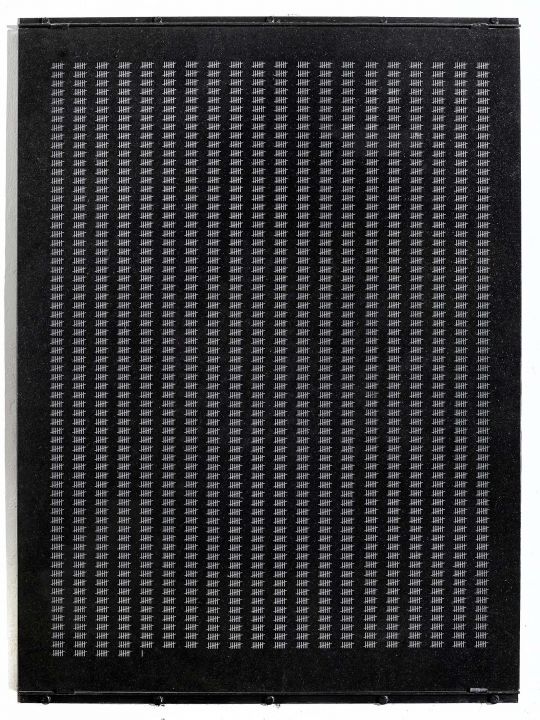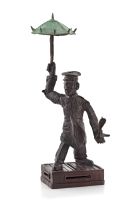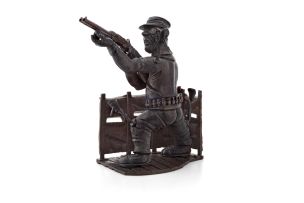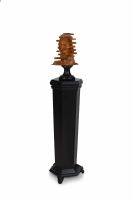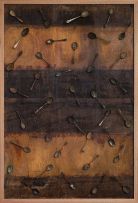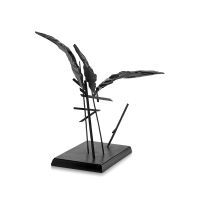Prison Hacks: Walter Sisulu
Willem Boshoff
Incl. Buyer's Premium & VAT
About this Item
engraved with the title: Walter Sisulu 11 Jan 1964-15 Oct 1989
Notes
"I wanted to evoke a sense of abstraction, a meditative quality arising from the whole process of counting days and passing time, to the point at which you lose yourself completely."1
1. Willem Boshoff, 'Prison Sentences/Prison Hacks' [online] Available: https://www.willemboshoff.com/product_page/prison-sentences-prison-hacks (12 January 2018).
The work, Prison Hacks: Walter Sisulu forms part of a project consisting of a series of eight granite slabs. When I first thought of this project my initial idea was to make a series of etchings to record the number of days spent in jail by the eight political prisoners (Nelson Mandela, Ahmed Kathrada, Walter Sisulu, Raymond Mhlaba, Elias Motsoaledi, Andrew Mlungeni, Govan Mbeki, and Dennis Goldberg) who were sentenced to life imprisonment at the close of the Rivonia trial in June 1964. Most were released only in 1989-1990. I appointed a number of assistants to calculate the exact number of days each of them spent behind bars, taking leap years into account. In the case of Dennis Goldberg, we actually went to visit him to ascertain precisely the number of days he was imprisoned, as he was released the earliest. It emerged from the research we did that seven years of prison is considered by the inmates to be a very long time, which feels never-ending, almost like an eternity. The prisoners speak of it as a neves, which the Oxford Dictionary defines as an extended period of prison sentence. (When written backwards, neves spells the word 'seven'.) Realising that the measurement of time was a very important idea, I felt I would be throwing it away by simply translating that concept into a series of prints, so I decided to make these works in granite.
With my assistants I started to experiment on the computer to find the most meaningful way to represent these prison sentences. Initially I could afford to make only three panels: those for Nelson Mandela, Walter Sisulu and Ahmed Kathrada. I liked the title Prison Hacks, because a hack is a term for a person hired to do dull routine work, but also means a line that you draw through something. Each prisoner counts the days of his or her sentence already served by scoring a vertical hack through each day. After six days a diagonal is scored across the verticals to close a week's number of days. This is done on a wall, in a private place, perhaps in a cell or toilet. Walter Sisulu spent 9269 days in prison, from 11 June 1964 to 15 October 1989.
Having received life sentences, these prisoners were going to be incarcerated forever. A man like Mandela did not sit in jail for one period of neves, but for four. It is crazy to doom one person to spend the remainder of a lifetime behind bars purely because of what he thought. This work is strongly related to Bangbroek (1978-1981), a work in which I was also toying with the idea of prison. (It had to do with my own refusal to continue to do military service.) So I wanted to create a link between the two works, which were made 24 years apart.
Once I had received the commission to make all eight panels, I altered the title of the project to Prison Sentences. (Individual panels, such as the Walter Sisulu one, are each called Prison Hacks.) The word 'sentence' refers to the term a prisoner serves, but it also denotes a grammatical whole with a full stop, an ending. Naming the work Prison Sentences alluded to the second meaning, the idea that one would expect a sentence to end. I wanted to evoke a sense of abstraction, a meditative quality arising from the whole process of counting days and passing time, to the point at which you lose yourself completely. I chose the black granite as it is the material of a graveyard. It is also the material used to build memorials. Each panel is reflective, so you see yourself in it: in a sense it becomes a mirror of the self.
- Willem Boshoff
Literature
cf. Bronwyn Law-Viljoen. (ed.) (2008). Art and Justice: The Art of the Constitutional Court of South Africa, Johannesburg: David Krut Publishing. A similar example is illustrated on pages 128 to 131.
cf. Warren Siebrits. (2007) Willem Boshoff: word forms and language shapes 1975-2007, Johannesburg: Standard Bank Gallery. A similar example is illustrated on page 89.
